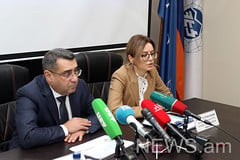
By Aram Gareginyan
YEREVAN. – Yerevan residents will benefit from switching to trolleybuses from minivans, Mr Mark Davis, head of the Yerevan Resident Office of the European Bank for Reconstruction and Development, told Armenian News – NEWS.am.
Currently, a project for renovating trolleybus fleet and connection grid is in the pipeline for Armenia, he said. Since the project will help to reduce carbon footprint, it can attract funding from E5P. The Eastern Europe Energy Efficiency and Environment Partnership (E5P) is a multi-donor organization which funds green economy projects The E5P includes contributions from a number of Northern and Eastern European governments, including Armenia, which pledged one million euro commitment to the Partnership. E5P provides grants alongside loans for eco-friendly municipal development projects.
With all their importance for the city’s environment, trolleybuses are far from being a mainstream mass transit mode: in 2014, they served a mere 2.6% of Yerevan’s passenger flow.
There is no exact data on the project yet, but in theory it would qualify for EBRD financing, Davis said.
The EBRD will need to work further with the Yerevan municipality and the national authorities to secure sovereign guarantees. Credit agreement will require either a municipal or a sovereign guarantee, but the latter is preferable, because Yerevan municipality has limited room for to borrow (debt service must not exceed 20% of capital budget expenses). Besides, the municipality will be considered less creditworthy than the government, which would lead to a higher cost of financing and a shorter maturity.
The feasibility study underlying the project is in its final stage, and one of the key findings is clear as day: mass transit, based on minivans, is an obvious disadvantage for the city.
“Marshrutkas [minibuses], as they call them, are perhaps not regulated the best way, and there’s a problem with their driving practices – obviously they are horrendous,” Davis underlined.
On the other hand, there’s a notable mismatch in ridership: though a minivan ride costs twice the trolleybus one, the former are packed, and the latter are empty most of the time.
Most likely, the core issue lies with the transport routes: those of the minivans are much more elaborated and allow commuting nearly everywhere in the city without switching, which is not the case for trolleybuses.
Secondly, privately owned minibus operators tend to disregard working hour limits and try to have their drivers ride as much as possible. However, this frequency also makes minivans a passenger’s choice.
Here, the Yerevan municipality needs to step up with a regulatory solution to channel passengers to trolleys and the subway: private businesses are not going to do that and lose passengers, Davis underlined.
“Without a sound regulatory framework on the table, any investment in trolleybuses will be just putting nice new empty vehicles in the streets of Yerevan, and that’s not what I think the municipality wants to do,” he added.
To remind, commuting patterns in Yerevan are being studied with the assistance of the Asian Development Bank, as part of its Yerevan West Bypass Highways project.
According to the estimates of the municipal trolleybus operator, “Electric transport of Yerevan” CJSC, around 60% of the trolleybus fleet in the city is past useful age. 70% of the contact grid and 90% of power supply substations are worn out.
“Of course the project will go into technical details as well. On the bottom line, we are going to propose a comprehensive solution, calculating costs and benefits. Right now the city authorities are interested, along with us and the E5P. We’ll have to see if there is a sovereign guarantee for the project and if it’s bankable. And of course, one needs to make sure regulatory issues with passenger flows are dealt with, otherwise the project will not make sense,” Davis concluded.






















